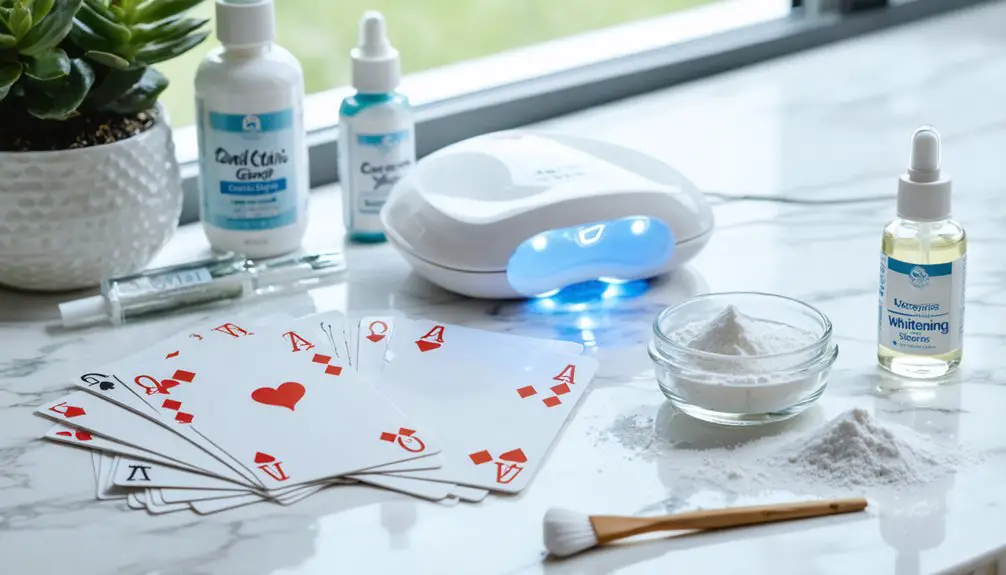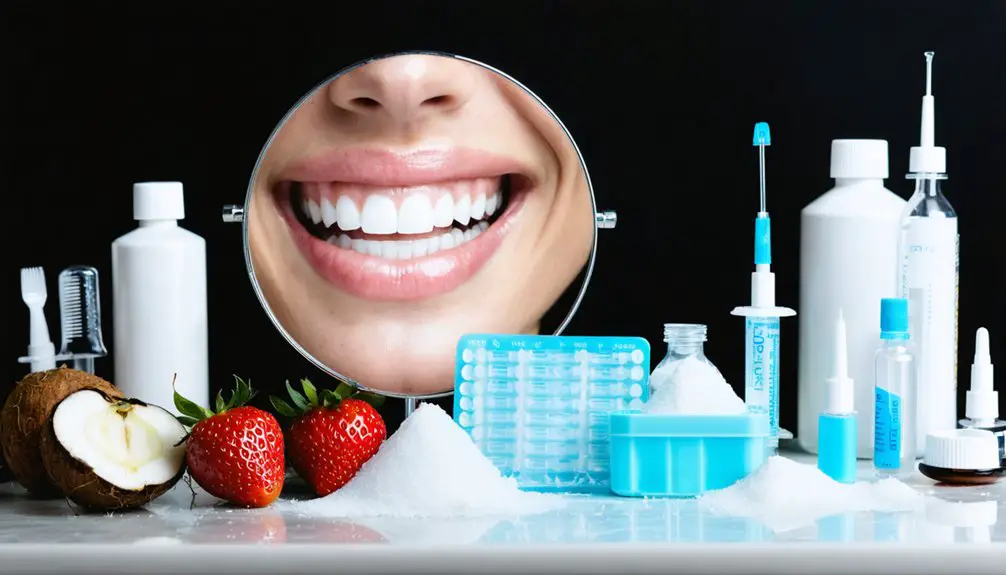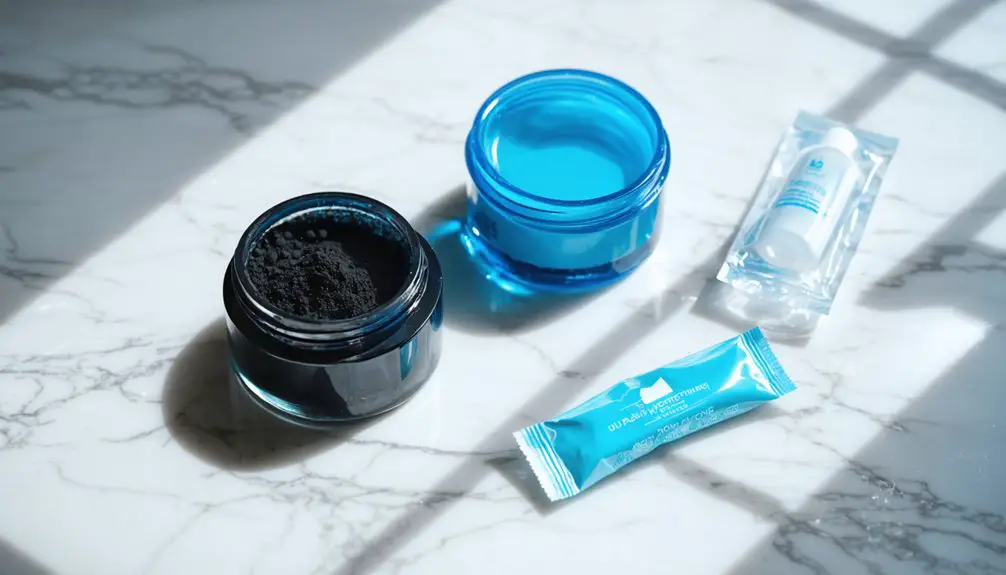You’ll find effective at-home teeth whitening through several budget-conscious options. Crest 3D Whitestrips ($45-60) offer reliable peroxide-based whitening, while Plus White 5 Minute system ($11.49) provides traditional tray application at significant savings. For sensitive teeth, consider Crest’s Gentle Routine Kit ($20-50) or Sensodyne Extra Whitening toothpaste. Custom-fit trays maximize whitening agent contact, and boil-and-bite alternatives keep costs low. Discover how to maintain your brighter smile through proven techniques and strategies.
Key Takeaways
- Plus White 5 Minute system at $11.49 offers effective whitening through traditional tray application, making it highly cost-effective.
- Combine daily whitening toothpaste with boil-and-bite trays for an affordable, gradual improvement in tooth color.
- Use Crest 3D White Whitestrips Gentle Routine Kit ($20-$50) for safe, reliable results without professional intervention.
- Maintain results with whitening mouthwash and proper oral hygiene to extend time between treatments and reduce costs.
- Create a DIY whitening routine using custom-fitted trays and over-the-counter peroxide gels for long-term, budget-conscious results.
Smart Shopping Guide for At-Home Whitening Systems
When selecting an at-home teeth whitening system, understanding the interplay between effectiveness, cost, and safety becomes essential for making an informed decision.
Your product comparison review should focus on whitening ingredient effectiveness, starting with hydrogen peroxide-based options like Crest 3D Whitestrips, which deliver reliable results at a mid-range price point of $44.99-$60. Tests showed these strips whitened teeth 2.6 shades in just two weeks with consistent use.
You’ll find budget-conscious alternatives in the Plus White 5 Minute system at $11.49, offering effective whitening through traditional tray application. The system’s hydrated silica-free formula helps protect tooth enamel during treatment.
For ideal results, consider custom-fit trays that maximize contact between whitening agents and teeth. While premium options like Smile Brilliant cost more initially, their personalized fit often yields superior outcomes.
Remember to evaluate peroxide concentration levels, as higher percentages can increase sensitivity while potentially accelerating results.
Affordable Whitening Options for Sensitive Teeth
Many individuals who want whiter teeth face a common obstacle: tooth sensitivity. Understanding sensitivity causes is vital – exposed dentin tubules and eroded enamel often trigger pain during whitening treatments. Professional dentists can customize treatment plans based on sensitivity levels.
Natural alternatives like coconut oil and sage extract provide gentle whitening effects. However, you’ll find several budget-conscious options designed specifically for sensitive teeth.
Consider Crest 3D White Whitestrips Gentle Routine Kit ($20-$50), which uses gentle ingredients and reduced peroxide concentrations. Sensodyne Extra Whitening toothpaste offers an economical daily option that both whitens and desensitizes. For a portable solution, TrueWhite Whitening Pen contains mild whitening agents suitable for sensitivity.
Before starting any whitening regimen, make sure underlying dental issues are addressed. Look for products containing potassium nitrate to block nerve pain and fluoride to strengthen enamel, maximizing comfort while achieving your desired results.
Getting Professional Results With DIY Whitening Methods
Although professional dental treatments deliver faster results, you can achieve significant whitening at home by understanding proper DIY techniques and their limitations. Using a combination of mild abrasive agents and peroxide-based products allows for safe yet effective stain removal. At-home methods typically achieve 2-4 shade improvements with consistent application.
To maximize whitening effectiveness while addressing safety concerns, you’ll need to focus on enamel protection and follow proper application protocols. Professional-grade take-home kits with custom-fitted trays offer the best balance of safety and results for DIY whitening.
- Use custom-fitted trays that prevent gel from contacting sensitive gum tissue
- Apply whitening products consistently according to instructions, avoiding overuse
- Choose peroxide-based products over abrasive or acidic natural alternatives
- Monitor for tooth sensitivity and reduce frequency if discomfort occurs
- Maintain results through proper oral hygiene and periodic touch-up treatments
Maximizing Results While Minimizing Costs
Achieving professional-grade teeth whitening doesn’t require spending hundreds at the dentist’s office. Through strategic DIY whitening approaches, you can maximize results while maintaining a practical budget.
Begin with a cost analysis of over-the-counter options, prioritizing tray-based systems or whitening strips that offer the best value-to-result ratio. Regular use of whitening mouthwash products can help maintain results between treatments while promoting better oral health. Following the recommended concentrations of peroxide-based treatments helps prevent damage to tooth enamel while still achieving desired results.
Combine chemical whitening products with natural methods to extend treatment longevity. Use baking soda or hydrogen peroxide rinses between primary whitening sessions, and incorporate whitening toothpaste into your daily routine.
To optimize effectiveness, maintain strict adherence to manufacturer guidelines while avoiding staining agents during treatment periods. Consider boil-and-bite trays as an economical alternative to custom-fitted options, providing comparable coverage at a fraction of the cost.
Long-Term Strategies for Budget Teeth Maintenance
Maintaining your whitened smile requires a strategic combination of daily practices and periodic interventions that won’t strain your budget. Focus on long term oral hygiene through consistent brushing with fluoride whitening toothpaste and daily flossing to prevent stain accumulation. Using a straw while drinking can significantly minimize contact between staining beverages and your teeth. Professional treatments deliver dramatic results but budget-friendly alternatives can be equally effective with consistent use.
Your dietary choices greatly impact whitening longevity – minimize exposure to staining agents and incorporate natural teeth-cleaning foods into your routine.
- Brush gently with whitening toothpaste twice daily, using circular motions
- Floss methodically between each tooth pair, ensuring complete plaque removal
- Rinse immediately after consuming coffee, tea, or red wine
- Crunch on raw carrots and apples as natural tooth cleaners
- Schedule professional cleanings every six months for thorough stain removal
These preventive measures help maintain your results while avoiding costly corrective treatments later.
Frequently Asked Questions
Can Whitening Products Damage Existing Dental Work Like Crowns or Veneers?
No, whitening products won’t damage your dental work. Your crowns and veneers are made of durable, stain-resistant materials that maintain their integrity when exposed to whitening agents during treatment.
How Soon After a Dental Cleaning Should I Start Teeth Whitening?
With your smile fresh as morning dew, you can start teeth whitening immediately after your dental cleaning for ideal results, though waiting 24-48 hours reduces sensitivity if your gums feel tender.
Are Natural Whitening Alternatives Like Charcoal or Baking Soda Actually Effective?
While baking soda provides safe, mild whitening through gentle abrasion, charcoal’s effectiveness is limited and may damage your enamel. Neither matches professional treatments, but baking soda offers a safer natural option.
Can Teenagers Safely Use At-Home Teeth Whitening Products?
While you’re concerned about teenage dental health, your teen can safely use at-home whitening products after age 14, provided you’ve consulted a dentist and follow safe whitening practices with adult supervision.
Do Medications Affect the Effectiveness of Teeth Whitening Treatments?
Yes, different medication types can greatly impact your whitening treatment’s effectiveness. Some antibiotics and antipsychotics create intrinsic stains that resist whitening, while others cause interactions that may reduce bleaching results.
References
- https://www.goodhousekeeping.com/health-products/g28723133/best-at-home-teeth-whitening-products/
- https://www.tribecasmiles.com/best-teeth-whitening-kits-with-trays-2025
- https://www.varnidental.com/blog/teeth-whitening-whats-new-what-works-and-what-to-avoid
- https://g-p-dental.com/best-teeth-whitening-kits-in-2025-safe-option/
- https://alignerco.com/blogs/blog/complete-guide-to-teeth-whitening
- https://nhdentistrybeverlyhills.com/press/6-of-the-best-teeth-whitening-kits-in-the-drugstore/
- https://pmc.ncbi.nlm.nih.gov/articles/PMC10024105/
- https://www.cnet.com/health/personal-care/best-teeth-whitening-kits/
- https://smiledailey.com/teeth-whitening-for-sensitive-teeth-is-it-safe/
- https://www.westriverdentalcare.com/best-teeth-whitener-for-sensitive-teeth/



